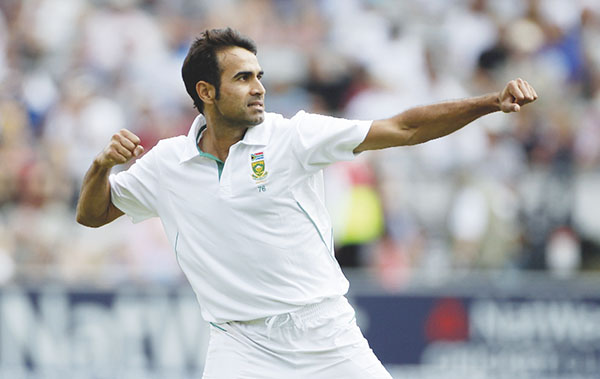Imran Tahir is the blueprint for how to manage Proteas players who fail at their first crack at international cricket. By Ryan Vrede
Utter rubbish was peddled about after Imran Tahir’s match-winning 5-32 against Pakistan in Dubai last year. There was no great comeback from the cricketing wilderness, as large sections of the South African cricket fraternity asserted. That was an ill-considered but convenient and lazy description of a player who had rebuilt his confidence after it seemed it had been irreparably fractured at the hands of Australia in Adelaide in 2012.
Zero wickets for 180 – the second-worst innings return for any South African bowler in history – left him distraught, but not defeated.
The truth is that Tahir, in Dubai, was a product not only of his own incredible resolve, which refused to be shaken, and a talent that endured a test lesser men would have failed, but largely of astute management. Tahir was never in the wilderness. That term, in a cricketing context, implies abandonment, distress and hopelessness.
Certainly, Tahir was left disheartened by his showing in Adelaide, and accepted his subsequent axing as fair. But he was never left feeling he had blown his international career.
This player-centred approach is a big part of what defined Gary Kirsten’s reign as the Proteas’ head coach. Kirsten had the required perspective on the situation. Adelaide, in its current guise, is a batting paradise – just last year in the second Ashes Test, Australia posted 570-9 declared in their first innings, with Graeme Swann, who was among the world’s pre-eminent spinners at the time, taking just 2-151, one of those wickets coming with the slog on at 474-7.
Kirsten also had an unwavering belief in Tahir. He had nurtured Tahir during his tenure and offered him support and a solution in the wake of the Adelaide mauling. The plan was detailed for him – he’d return to domestic cricket with a clear indication of what he needed to do to play international cricket again. Kirsten’s successor, Russell Domingo, had been intimately involved with the plan and continued rolling it out when he took over. When Tahir grasped his second chance in Dubai, it was the culmination of a focused recovery programme, and while the outcome may have exceeded expectations, the performance didn’t come as a surprise.
‘In the wake of that Adelaide Test we had to make some tough choices with regards to Imran’s career,’ Andrew Hudson, convener of the national selection committee, begins.
‘We’ve always believed in his ability to win matches and that belief wasn’t diminished because of what happened in Adelaide.
‘But we also had a responsibility to the player and team to ensure that he was the strongest possible version of himself. So we had to establish how that could be achieved, and how to do so without breaking Imran. He was open to our plan, and in hindsight it has turned out precisely how we hoped it would. I must stress, however, that it is one thing to set the structures in place for a player’s recovery, but it is ultimately up to that player to show the determination and skill to get back. Imran has been a model of these things.’
In his post-match interview after his Dubai bow, Tahir spoke of the assault on his confidence, but reaffirmed that he always believed he wasn’t an impostor at international level. He thanked those who had supported him through a difficult period, and spoke of the growth he had experienced as a player and man, and how that growth had positively influenced his game.
Hudson asserts that Tahir’s growth has been significant and has had unforeseen spin-offs. ‘He has become an incredible asset to the Proteas,’ Hudson says. ‘The management and skipper are very careful about how and when they use him. They never want to compromise his potential for success. But in conditions that suit him, he is a massive weapon to have.
‘What’s more, his value has clearly extended to ODI cricket. We are acutely aware that having a spinner who is able to turn it both ways is critical. He has an X-factor not many players in the game have. When he is at his best, he can be the difference between winning and losing.’
Hudson’s offering of ‘when he is at his best …’ confirms that the selectors feel the same degree of uncertainty about which Tahir will show up that an appreciable section of the support base does (the others think he is an absolute success or disaster waiting to happen). He doesn’t yet inspire the confidence that his Dubai-style feats are replicable consistently.
It’s that consistency that is the next level in his evolution. But that really isn’t the issue at this point. We should be celebrating the manner in which a player of notable skill but (initial) poor delivery on expectations has been managed. This certainly hasn’t been the case in the past, with many a talented rookie player’s career ended quickly, painfully and without so much as a thought of remedial action.
Tahir is a blueprint for similar cases in future. The skill, in this regard, is discerning between the struggles of a terminally hopeless player and one that possesses the ingredients to succeed but is struggling to settle. The investment needs to be worthwhile.
Tahir is in an environment that aims to give him every chance to succeed.
This feature was first published in issue 123 of SA Cricket magazine.
Photo: Backpagepix







